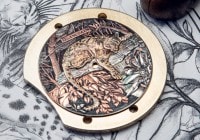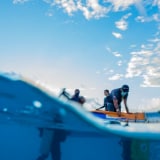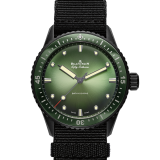
Search in Issues
Chapters
Chapter 8
MOKARRAN
An expedition to protect the largest of the hammerhead sharks and a Bathyscaphe dedicated to the mission.
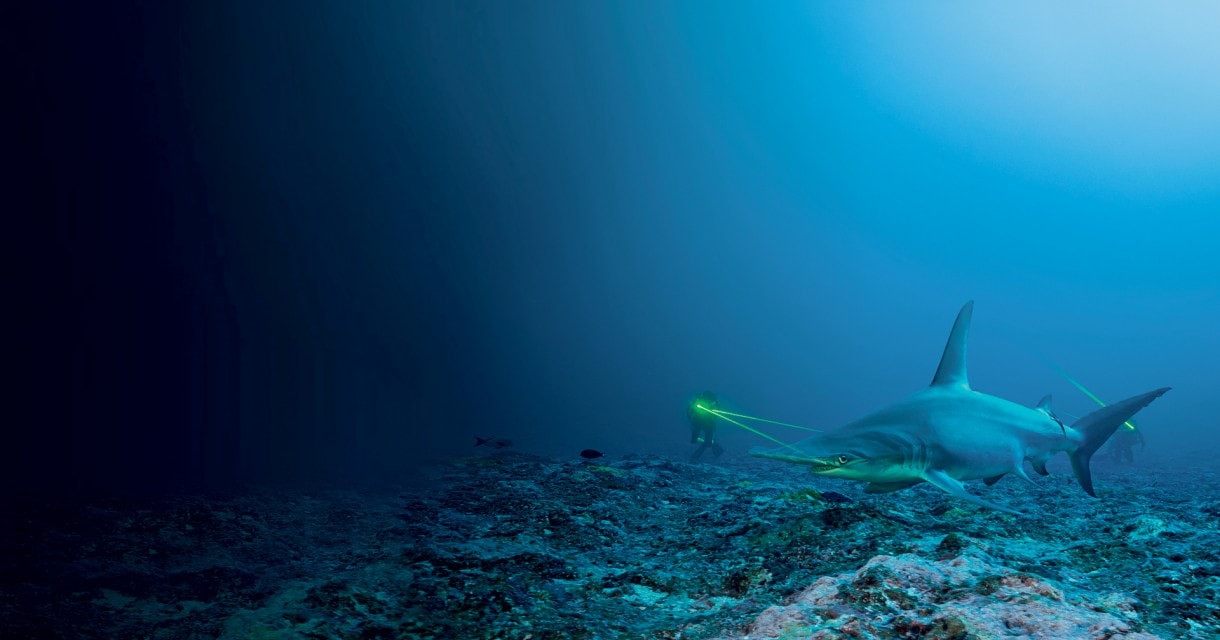
Blancpain’s CEO Marc A. Hayek is PERSONALLY ENGAGED in supporting the efforts of the Mokarran Protection Society.
Blancpain has not only been deeply connected with the history of diving and underwater exploration, it has also become a key force in protecting the biodiversity of the oceans. Founded in 2014, the Blancpain Ocean Commitment initiative (BOC) is a unique program that has already helped a number of environmental initiatives get off the ground (some of them underway and supported by Blancpain before the BOC was launched). A recent example is a project with the Mokarran Protection Society to measure and identify great hammerhead sharks in French Polynesia, and to lay the essential groundwork for more effective conservation efforts in the future. The watch dedicated to this project was the first Fifty Fathoms Bathyscaphe with a green dial and bezel, issued in a 50-piece limited edition (Ref. 5005-0153-NAB A). It was also Blancpain’s first no-date version of the Bathyscaphe with a 43.6 mm case.
Blancpain has been a member of the diving community from the very beginning: Jean-Jacques Fiechter (born May 25, 1927), Blancpain’s Co-CEO from 1950 to 1980 and an avid diver himself, was one of the first to realize that — in addition to masks, fins, depth gauges and diving tanks — divers would also need a specialized timing device, a reliable instrument that could indicate the dive time at a glance. In the 1950s, Fiechter began experimenting with what would result in the Fifty Fathoms in 1953, implementing new ideas for the caseback and crown gasket that would much better protect the automatic timepiece from the constant pressure of water, resulting in patents for both designs. In addition, and also due to the fact that manual chronographs could not be operated underwater at this point in watchmaking history, Fiechter and his team introduced the iconic unidirectional bezel that would allow the watch’s wearer to keep better track of how much time was spent underwater. Since professional divers represented a comparatively limited market potential, the increasingly popular category of recreational diving would be key to the model’s commercial success: “The Bathyscaphe was the next step that enabled a new audience to get in touch with diving and discover the underwater world”, Fiechter recalled in 2013, when Blancpain launched the first model of the current Bathyscaphe to commemorate the 60th anniversary of the Fifty Fathoms collection. He added, visibly moved: “It’s almost a miracle that, 60 years after, I find another passionate diver at the helm of the company.”
Marc A. Hayek (born Feb. 24, 1971) once jokingly admitted that he’d rather “be underwater than around meeting room tables”, if given a choice. As Blancpain’s CEO and passionate diver, he had already successfully reintroduced the current generation of the Fifty Fathoms in 2007 (following the smaller, 50th anniversary edition from 2003), which also saw the introduction of a new in-house movement (Caliber 1315) with 5-day power reserve. The relaunch of the Bathyscaphe in 2013 was followed by the start of the Blancpain Ocean Commitment initiative in 2014 with the Fifty Fathoms Bathyscaphe Flyback Chronograph Ocean Commitment I (Ref. 5200-0240-52A), powered by the new F385 movement and the first use of high-tech ceramic for the case.
Following the success of this watch, Blancpain extended the initiative in 2016 with the Ref. 5200-0310-G52A Bathyscaphe chronograph with blue ceramic case and unveiled in 2018 the third BOC timepiece (Ref. 5008-11B40-52A). All three were issued in 250-piece limited editions and each sale generated an additional €1,000 donation made for each watch in the series, in addition to the annual funding granted by Blancpain. Collectors of one of these highly sought-after limited-edition watches also received membership of the Blancpain Ocean Commitment Circle, giving access to exclusive advantages, including invitations to private BOC events and talks re-garding ongoing scientific expeditions financed by Blancpain.
Although the even more exclusive Mokarran Limited Edition (Ref. 5005- 0153-NAB A) was not officially a BOC edition, Blancpain decided to include an access code to join the BOC Circle and also included a framed photograph from the January mission. This inclusion was another step in raising public awareness as well as towards achieving the brand’s goals of helping to understand, preserve and protect the world’s oceans.
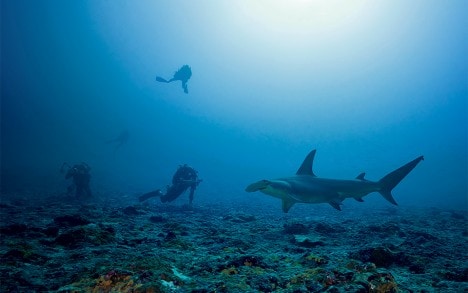
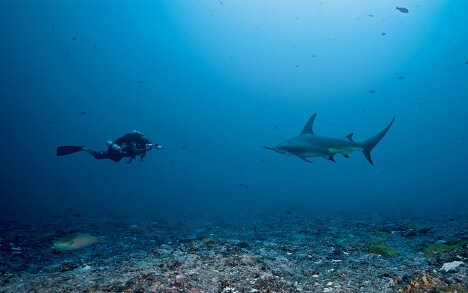
Unsurprisingly, sharks are a constant presence in the life and culture of Polynesian peoples, known as the ma’ohi and living in harmony with the ma’o (the great hammerhead’s Tahitian name is “ma’o tuamata”).
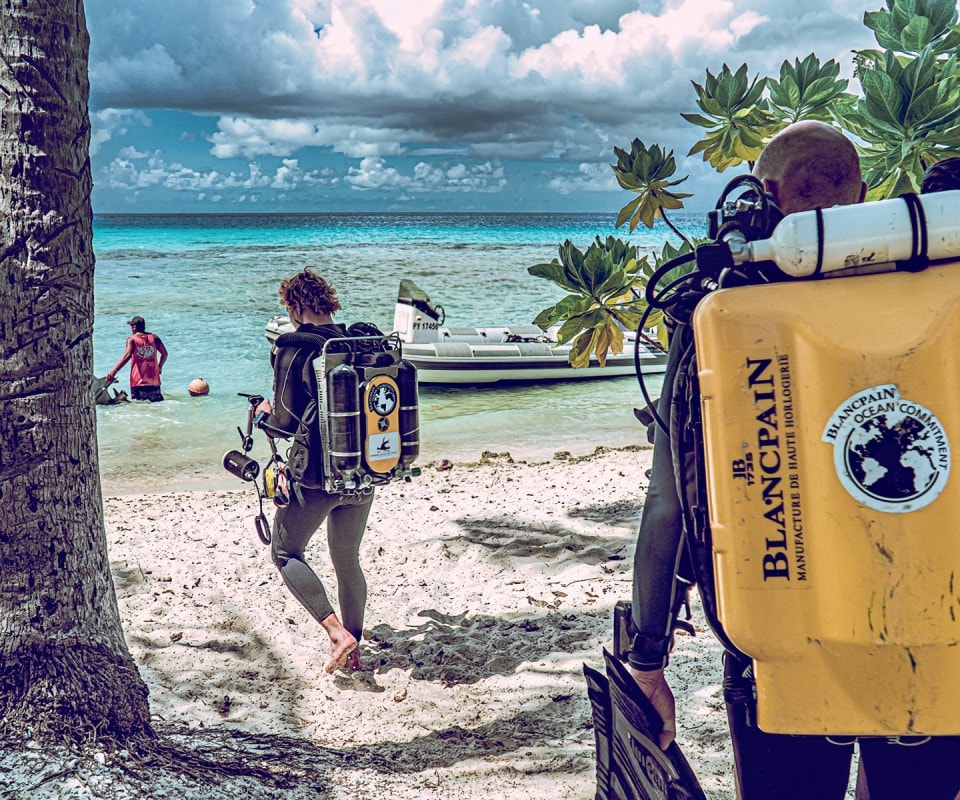
The same can be said for the newly founded Mokarran Protection Society: its President Jean-Marie Jeandel sees the NGO as an “alliance of competences to better understand the great hammerhead shark”. The growing team of biologists, computer scientists and divers started to operate from December 2019 from the Rangiroa Plongée dive center, which has in itself been supporting different ocean conservation projects since it began operating in 2008. As with previous projects, Blancpain pledged an additional donation of $1,000 per watch.
Rangiroa, often called the “infinite lagoon”, is the largest atoll in the Tuamotu Archipelago, a French Polynesian group of almost 80 islands and atolls forming one of the world’s largest chains of atolls. It is located about 220 miles northeast of Tahiti and is home to about 2,500 people. Together with Fakarava in the Tuamotu islands, Rangiroa is regarded as a major underwater diving destination because of the lagoon’s crystalline waters and abundant marine life teeming with over 800 species, as well as one of the highest concentrations of sharks in the world. Jacques-Yves Cousteau ranked it among “some of the world’s most beautiful scuba diving spots”. One reason for this is the fact that each high tide creates a strong incoming current, while each low tide creates a strong outgoing current in the atoll’s two passes, Tiputa and Avatoru. When the current is flowing inward through Tiputa Pass, sharks gather at the entrance. Large manta rays, eagle rays, turtles, moray eels, schools of barracuda, grey reef sharks or black tip sharks can also be encountered, as well as tiger sharks and, occasionally, hammerhead sharks.
Great hammerhead sharks are not preyed upon by other marine animals, but are vulnerable to over-fishing, as they are caught incidentally and are commercially targeted for their fins. Aiming to provide better safeguards for the species, members of the Mokarran Protection Society study behavior, movement patterns, population and biology – all with a view to fostering implementation of appropriate management strategies.
In January 2020, Blancpain President & CEO Marc A. Hayek traveled to Rangiroa, French Polynesia, where he took part as a volunteer underwater videographer in a scientific expedition dedicated to the study of the great hammerhead shark, Sphyrna mokarran. Set up in collaboration with the Mokarran Protection Society, this first mission was intended to observe the behaviour of this large predator in the wild in order to identify and count its population in Polynesian waters.
The great hammerhead is the largest species of a total of nine hammerhead sharks, attaining a maximum length of 20 feet (6.1 meters) and weighing up to 1,000 pounds (453.6 kg). It is found in tropical and warm waters worldwide, inhabiting coastal areas and the continental shelf. The great hammerhead can be distinguished from other hammerheads by the shape of its “hammer” (called the “cephalofoil”), which is wide with an almost straight front margin, and by its tall, sickle-shaped first dorsal fin. Hammerhead sharks can sense electromagnetic fields, and their wide-set eyes give them a better visual range. A solitary, strong-swimming apex predator, the great hammerhead feeds on a wide variety of prey ranging from crustaceans and cephalopods, to bony fish, to smaller sharks and rays. Unlike scalloped hammerhead sharks, great hammerhead sharks are solitary and migrate long distances upward of 756 miles alone.
The Mokarran Protection Society, which consists mostly of volunteers, has been working onsite with a noninvasive technique called laser photogrammetry – basically a panel with two parallel lasers and a digital camera – that enabled them to project laser markings to measure, reliably identify and track individual sharks over time. The divers moved simultaneously in different areas, using open circuit and rebreathers, from the surface to a depth of 70 meters. Respectful approach methods were applied in order to minimize the divers’ effects on the top predator’s environment. The result of this effort will lay the groundwork for improving activities linked to the conservation of the species. Marc A. Hayek personally supported the Mokarran Protection Society over several that deep with the camera, I had to be certified as a dive professional. During my final diving exam here in the pass a couple of years ago, I encountered the largest hammerhead I’d ever seen. He swam right next to us, made eye contact and then disappeared into the deep. When I fully realized how significant this encounter was, it felt a bit like a rite of passage. I was given the okay to dive right here in the pass, which was both humbling and extremely moving.
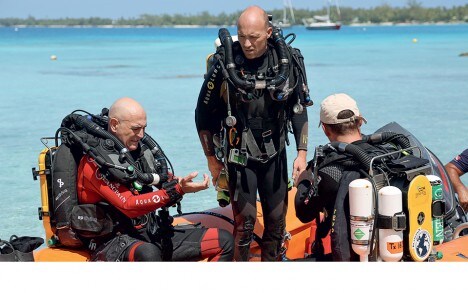
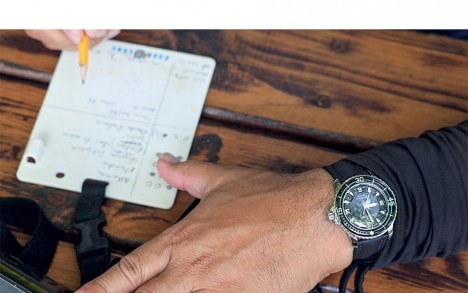
The Mokarran edition of the Blancpain Fifty Fathoms Bathyscaphe not only supports the work of the Mokarran Society, it also introduced a new color to the collection – with a green dial and unidirectional bezel featuring a matching green ceramic insert bearing markers made of Liquidmetal™. The latter is a proprietary material used in several other Blancpain watches and by other brands within the Swatch Group. The luminous dot index at 12 o’clock is a faithful reproduction of the one used on the original 1950s Fifty Fathoms watches. The 43.6 mm-diameter case is waterresistant to 300 meters and made of black ceramic with sweeping beveled lugs and a satin-brushed finish. The new sunburstfinish green dial features central hours and minutes hand based on the look of the vintage original; the date, usually located in a small window between 4 and 5 o’clock, has been removed, a first for the 43.6 mm version; while the large, red-tipped central seconds hand serves a utilitarian purpose for those diving with this watch, as an indicator that it is functioning.
The watch is equipped with Blancpain’s self-winding Caliber 1318, a robust movement with 204 components, 35 jewels and a high level of chronometric (precision timekeeping) performance. Its three series-coupled mainspring barrels provide an impressive five-day power reserve. The movement, visible through the watch’s clear sapphire caseback, has a balance spring made of silicon, a material that features several key properties: density that makes it particularly light, strong shock resistance, and imperviousness to magnetic fields. These help to optimize the geometry of the balance spring, thereby improving the isochronism of the movement and ultimately the accuracy of the watch. Blancpain’s 1318 is also fitted with a Glucydur balance with square-head gold micrometric regulating screws to improve precision and allow for efficient adjustment. The gold oscillating weight is engraved with a hammerhead shark.
Unsurprisingly, the entire 50-piece Fifty Fathoms Bathyscaphe Mokarran Limited Edition was sold out quickly, making an encounter with one about as rare as diving with a great hammerhead. The good news, however, is that the Manufacture recently brought those distinctive green dial and bezel colors to the Bathyscaphe Flyback Chronograph: the Fifty Fathoms Bathyscaphe Chronographe Flyback (Ref. 5200 0153 B52A with sail-canvas strap, Ref. 5200 0153 NABA with NATO strap) is available as an unlimited model. And the best news? The Mokarran Protection Society was able to make a first step towards better preserving a species critically threatened by extinction – thereby increasing the chances that future generation of divers might encounter one as well.
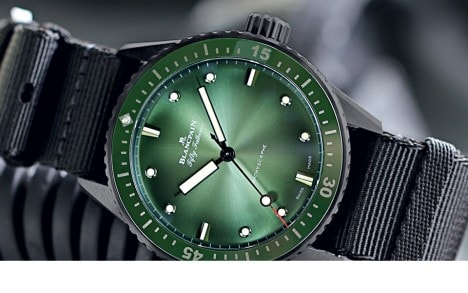
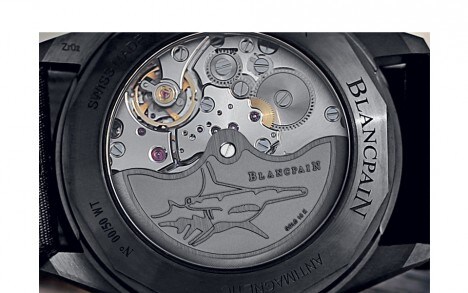
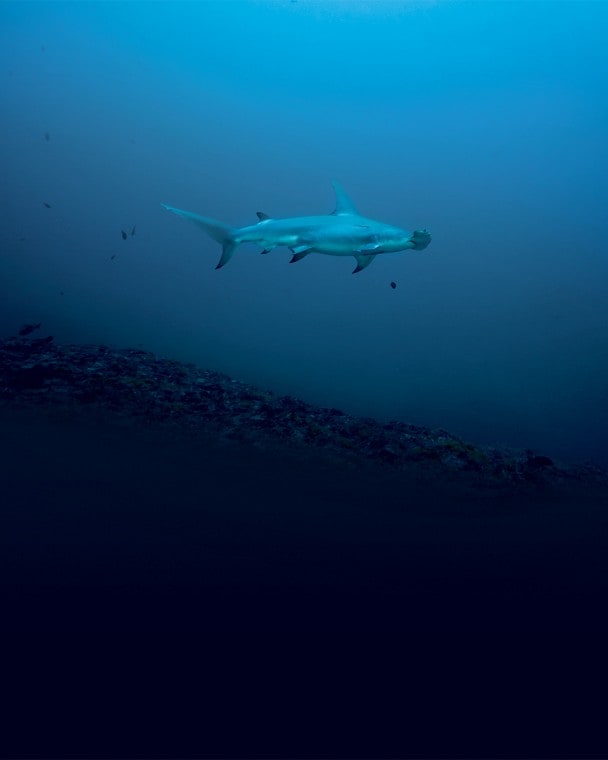
A Sanctuary for the Great HAMMERHEAD SHARK
In December 2019, the Rangiroa-based Mokarran Protection Society initiated the first phase of a comprehensive behavioral study of the great hammerhead shark (Sphyrna mokarran) that annually passes through the second largest atoll in the world each year (typically from December to March). Tatiana Boube, French marine biologist, environmental engineer and science coordinator of the project, explains, “The great hammerhead shark is among the most iconic species of the ocean, yet it is still poorly understood worldwide.” Using laser photogrammetry and photo identification, the team of experienced divers and marine biologists set out to determine the connectivity of individual animals and their migratory routes, an essential step toward developing and implementing conservation methods for the species over its entire range. Although they are protected in French Polynesia, little is in fact known about the critically endangered hammerhead sharks. Boube continues: “There is a sense of mystery surrounding what’s happening in Rangiroa. It is one of only two spots in the world (with the Bahamas) where one can encounter this critically endangered species, and yet no study has ever been conducted to understand what’s happening here: ‘Where do they come from or where do they go?’ ”
In short, until recently, Polynesia could have been either seen as a vital feeding ground, an area for breeding and giving birth; or it could have be a zone where the great hammerhead shark had settled. Says Boube, “As we were starting from scratch, the main goal of the first season was to get a primary description of the population’s characteristics regarding the male and female ratio, the size of the population (how many different individuals were observed during the season), the sexual maturity of the individuals (indicated by the size of the animal), as well as their seasonal site fidelity (are the individuals observed throughout the season, sign of a potential site fidelity behavior, or are they only stopping by on their migration route?). We also looked at potential environmental factors and their influence on the sightings of great hammerhead sharks in the pass.”
Between January and February 2020, the non-profit organization diving team therefore spent more than 300 hours underwater (up to a maximum depth of 70 meters) in order to detect, observe and register individual animals. Their ultimate goal was to create a comprehensive database, consisting of a photo and a detailed description of each animal. Says Boube: “We used distinctive features on the shark’s body to distinguish each of them: damaged fins, pigmentation, or spot patterns. Laser photogrammetry, on the other hand, provided the exact measurements of the individual shark from a distance. Each shark identified now has its own ‘ID sheet,’ enabling us to compare future individuals sighted in the pass throughout the year but more importantly during the next high seasons. We can then assess the residency of these individuals.”
During the project’s first phase, 135 underwater encounters were logged, of which 63 were close enough to get proper measurements. Based on this effort, 29 individual animals in total were registered. Surprisingly, only four of them were observed again during the season, leading to the conclusion that a small group of animals spends the season in the area, while most sharks seem to use the atoll as a stopover on a much larger migration route. Boube points out: “While we do not know yet if they leave Polynesian waters on their migration, contrary to the reports of local dive instructors, [we now know that] there were not five or 10 seasonal resident individuals, but at least 29, only sexually mature females, of which a large majority seemed to have a low site fidelity index. It appears they tend not to stay more than a month or a few days in the area.”
Based on this vital insight for the protection of the great hammerhead shark, the team returned to the Tiputa site for the second phase of the project. Boube explains: “In terms of science, the team aims to complete and re-evaluate the identification work carried out last season (sex ratio, number of individuals, sizes) with a longer sampling period. We are looking at potential inter-annual residency, should the same individuals from last season be sighted again.” Simultaneously, the team is now also exploring small-scale migration between Rangiroa and Tikehau (a neighboring atoll located around 65 km from Rangiroa) by conducting the same identification work there: “If there is any match, this would be the beginning of a migration pattern.”
The team has also been conducting interviews with local fisherman and guides. Navigating year-round throughout the atoll for their livelihood, they may have key information on critical habitats for the species such as feeding, mating, pupping, or other aggregation sites. The Mokarran Protection Society will then gather all this local knowledge to address all hypotheses as to why these individuals gather at this time of the year in this area.
For Boube, the long-term goal is clear: “We aim to locate their key habitats and to trace their migration routes in order to establish whether or not they leave Polynesian waters throughout their life cycle. As sharks are protected here in French Polynesia (with a ban on shark fishing), this would mean that this territory is a reservoir for this species around the world. With adequate management measures, Polynesia could be a true great hammerhead shark sanctuary.” And she adds, “Thanks to the support of Blancpain, we have been able to deploy reliable scientific techniques (laser photogrammetry in OC and CCR diving), which are essential for the study of this species in the diving conditions of Rangiroa. All in all, this contribution enabled the association to get organized so as to undertake its first observation campaign, which brought unexpected scientific results, and to continue its work for its second mission.”
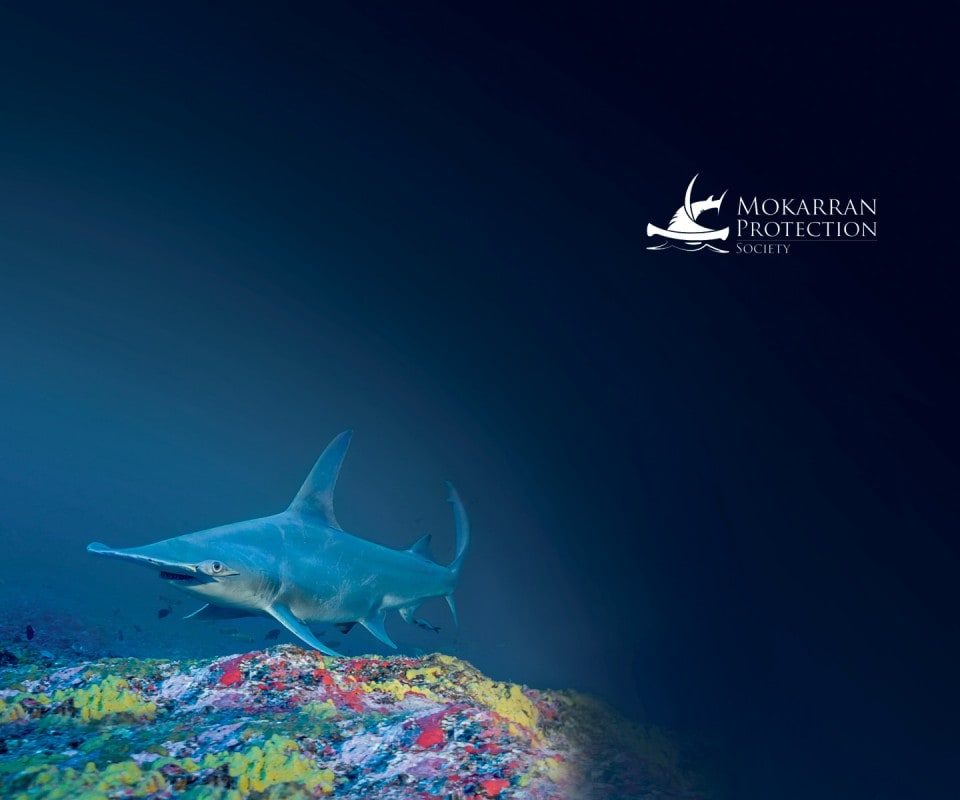
Other issues
Don't miss the latest issue
Sign Up for New Releases







